Entrance Mats Keep It Clean
Modular Matting Protects An Owner's Investment and Reduces Accidents
![]() Continuing Education
Continuing Education
Use the following learning objectives to focus your study while reading this month’s Continuing Education article.
Learning Objectives - After reading this article, you will be able to:
- Describe the function of entrance matting in a building.
- Discuss the types of entrance mats.
- Specify the proper entrance mat for a project.
- Explain the sustainability aspects of the product.
First Impressions Matter.
Upon entering a building, customers are judging their experience. Many factors are at play, but a clean, dry, safe floor creates a good first impression. There is a growing appreciation that in addition to providing a visual announcement for entries, proper entrance matting is important not only to the health and well-being of employees and patrons, but also to a company’s bottom line. Entrance mats are key in minimizing dangerous and potentially expensive slip and fall hazards. In addition, by stopping the transference of dirt and moisture deeper into the building, the right matting can protect an owner’s investment—floors inside the building remain in better condition, the life of tile and carpeted areas throughout the building is extended, and the need for costly floor care maintenance reduced. This presentation will detail the function of entrance mats and the various types of matting systems, focusing on the characteristics and performance of modular matting.Why Entrance Mats?
According to experts in the professional cleaning industry and in studies by ISSA, the Worldwide Cleaning Industry Association, as much as 80 percent of all the soil, dust, contaminants, and moisture entering a facility are tracked in on the shoes of building staff and visitors. Sustained tracking of dry soils into the building is a prime factor in the wearing of floors. Not only common dirt but, in the western states, sand can pose a formidable cleaning problem and severely damage high-quality marble and terrazzo floors.
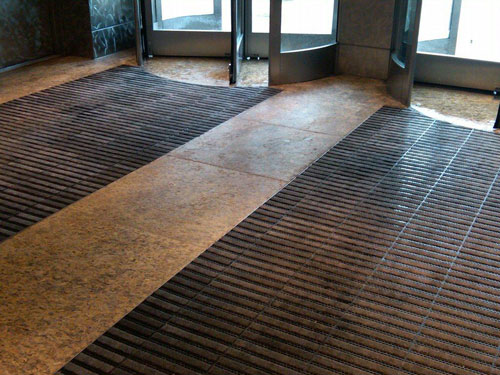 |
All images courtesy of Turtle Plastics |
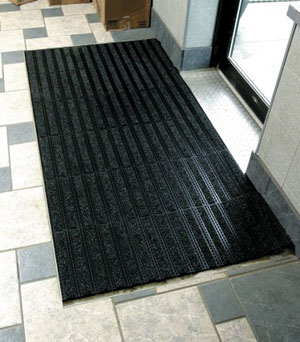 |
Entrance matting is key to protecting an owner’s investment. |
A matting system that can reduce soil being tracked into a building has a ripple effect in reducing cleaning and maintenance costs. Hard surface floors and carpets stay cleaner longer, without the need to mop, sweep, and vacuum as frequently. Less soil walked in also means preventing dust and debris from being ground into floors, decreasing the need for scrubbing and refinishing to repair the damage and restore the floors. Likewise, the requirements for periodic and complete carpet restoration are also minimized.
The statistics compiled by various stakeholders underscore the need for an effective matting system.
Maintenance
- The estimated cost of finding and removing a pound of dirt from a building is $600. (ISSA)
- One square yard of carpet can accumulate one pound of dirt in a week- twice that in inclement weather.
- 70 to 80 percent of dust, grime, and dirt in a building are tracked in from the outside on people's feet permanently damaging floors and carpets. (Institute of Industrial Launderers)
- Fifteen feet of effective, high-performance matting can trap and hold as much as 75 percent of this soil at the door; 30 feet can remove as much as 100 percent. (ISSA)
Safety
- Without effective entrance matting, as few as 1,500 people can remove 42 percent of the finish from a floor. (3M)
- Over 30 percent of worker injuries are slip related. (Wausau Ins. Co.)
- Without effective matting slip and fall exposure is increased. The average cost of a slip related injury exceeds $12,000 according to the Wausau Insurance Co. The National Safety Council puts the average cost of a slip-and-fall accident in the United States at approximately $50,000 per incident (including lost work time, worker’s compensation, and medical costs).
- In the USA each year, an average of 7.75 claims per 1-million supermarket customers are filed due to slip and fall incidents. (Food Marketing Institute)
What Entrance Mats Do
At their best, entrance mats are the first line of defense in protecting a building’s floors while decreasing maintenance costs and the possibility of slip and fall accidents. An effective matting system will fulfill the following four functions.
Stop Soil and Water at the Door
Some 85 percent of all soil that enters a building is tracked in by building occupants and visitors—and nearly all of that soil is dry soil that ranges from sizable particles to a fine dust. The primary purpose of an entrance mat is to remove that soil and any moisture from the shoe. While this appears obvious, not all entrance mats actually accomplish this goal. The most effective option is a mat that provides a combination of scraping and wiping to stop the spread of soil and contaminants. A mat with inferior scraping ability will wear quickly and not absorb moisture.
Store Soil and Water for Removal
Besides stopping soil, contaminants, and moisture at the door, an effective entrance mat should contain them to keep them from spreading and damaging surrounding surfaces, and creating slip and fall dangers. By minimizing the spread of contaminants, entrance mats can work to reduce the amount of required cleaning chemicals and their associated airborne contaminants and volatile organic contaminants (VOCs). This can represent a significant contribution to indoor air quality which, according to the Green Guard Environmental Institute, can be two to five times more polluted than outdoor air.
Most mats with flat borders do not provide the necessary containment. The most effective mat systems store soil and water where it can be safely and easily removed with minimal impact on the building.
Minimize Tracking of Soil and Water
Another key issue is how well the mat prevents soil from being reattached to shoes. Mats that minimize the reattaching of soil and water to footwear have a bi-level construction, with an upper “walking” surface that traps moisture and dirt so they won’t be tracked further into the facility and allows them to drop below the traffic surface to a reservoir that stores the soil and water for later removal and cleaning. Rubber reinforced mats of this type have the advantage of durability and relatively long service lives, minimizing the need for frequent mat replacement. However, mats with non-reinforced ribbed or cut pile face yarn alone do not hold up to foot traffic as well and tend to crush in a short period of time, thus allowing more water and dirt to reattach to shoes and be tracked into respective facilities.
Provide a Safe Surface
Entrance mats should always be slip-resistant. Mats that contain water in a reservoir below the traffic surface help prevent the leakage on to the adjacent floor surface where moisture can cause slipping hazards. Rubber vs. vinyl backed mats can offer slip resistant advantages. Vinyl-backed mats may curl, while rubber-backed mats do not. Some rubber-backed options also have cleated undersides for better non-skid properties and allow moisture to dry from underneath the mat.
Types of Entrance Mats
Mats can be made out of metal, rubber, vinyl, carpet, and recycled products and/or combinations of these materials. The type of mat system specified largely depends on the type of building, budget, expected foot traffic and climate considerations. First class commercial buildings and hotels, most government buildings, and airports tend to use the most expensive metal grid systems, or a combination of metal grid with brushing carpet. The more upscale chain stores would likely use either a plastic grid only or a plastic grid with brushing carpet, as would medium-grade commercial buildings and better schools. Most of these users would position the mat within a recessed area so there is no change in the walking surface. Apartment buildings, less affluent schools, and less expensive motels are likely to use a carpet mat without a recess and, in many cases, would rent those mats.
Modular Matting
Modular matting has the advantage of being used in recessed areas or directly on the floor surface. Open-grid modular, interlocking tiles are typically made from recycled Polyvinyl chloride (PVC), a material commonly used in construction for its durability, cost-effectiveness and workability. The PVC tiles are flame resistant and are resistant to oils, solvents, acid, and other chemicals. In some mats of this type, integrally molded plastic mini shock absorbers provide a resilient comfortable feel. Slip and falls are minimized because the tiles raise the foot traffic plane above the slippery surface of the supporting floor. This type of matting also helps prevent tripping as the inherent flexibility of vinyl combined with interlocking tabs, allows the mat to "drape" over uneven, cracked floors making a uniform, smooth, and safe walking surface.
PVC can be combined with inserts such as tufted carpet on each tile to aggressively remove dirt, mud, snow and other debris from shoes as feet wipe across the mat and are then drained through the open grid. Several grades of aggressive carpet inserts are available to accommodate high use areas and severe climate situations. The "open waffle grid" design may incorporate well spaced supporting feet to provide maximum drainage of fluids, facilitate frequent cleaning to maintain sanitary requirements and allow air circulation to keep floor and tiles dry. Dry floors and tiles are essential to help retard odor build-up, the spread of infectious mold, mildew, and bacteria.
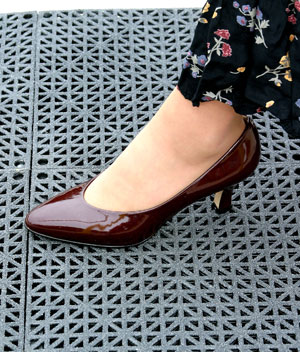 |
Drainage holes keep entrance mats high heel proof. |
If carpet inserts are appropriate, the most effective polypropylene carpet inserts are solution dyed with UV inhibitors added and are color fast, non-absorbing, odorless, crush-resistant, and made of non-shedding fibers such as multi and mono filament. Some manufacturers offer small 0.3 square inch drainage holes to prevent high heels from getting caught in the tile.
Entrance mats can be placed in one—or all—of three areas in a building.
Outside Mats
Outside entry mats are weather resistant and engineered to withstand direct exposure to the weather and harsh outside elements Modular matting can be used in exterior situations. Exterior mats allow water to drain off the walking surface, and are typically constructed from non-absorbent materials, such as rubber and quick drying fibers that stand up to extreme weather conditions. An exterior scraper mat can trap and store soil, sand and ice melt in deep grooves below the surface. An outdoor mat should be thick enough to withstand a harsh environment and relatively large debris particles. Outdoor mats work best in situations where there is a building overhang or canopy to the mats against direct exposure to the elements.
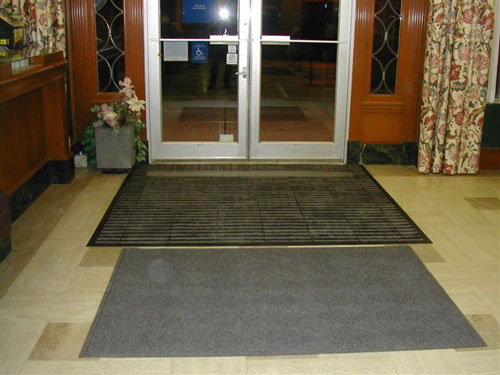 |
Vestibule mats can minimize unwanted dirt and moisture from spreading within a building. |
Vestibule Matting
Inside entrance doors, in foyers, or between double doors, bi-level vestibule entrance mats can minimize unwanted dirt and moisture from spreading within the building. Typically, the mat and accompanying frame are laid into a recessed area and become part of the building. The frame, which is usually aluminum but can be an architectural bronze or other metal, gives the recessed area a straight edge and, in new construction, is usually installed when the concrete is poured.
Modular matting can work well in a recess. Most recessed entrance mats are “grid style,” that is, they have some kind of carpet or abrasive strips that remove dirt, slush, and water which then falls through the grid, and remains in the recessed area until it is removed by a wet dry vacuum. Available inserts range from nylon, carpet with brush fibers, hard vinyl peaks, or coarse grit embedded into hard vinyl. The proper selection of insert material is climate dependent, as an absorbent material is important in a wet climate and an abrasive insert more effective in a drier environment where sand and soil are prevalent. For extra anti-slip surface, an aggressive urethane coating containing ground rubber particles can be used for a good walking surface.
Placed in a well or recessed surface, these mats become the finished floor, with the height of the mat flush with the lip of the well to eliminate trip hazard. These mats are referred to as “loose lay,” that is, they stay in place without the need for adhesives, frames, or any type of fastener.
Open grid mat systems remove, trap and hide dirt and moisture below the mat surface and are more effective than carpet-only mats, which leave no place to store moisture and soil. In areas where snow is an issue, the entrance matting tends to get saturated quickly. When walked on, saturated carpet mats will “squish,” and leak water out the sides, which signals that the mat has lost its effectiveness in preventing moisture and dirt from spreading further into the building. With use and saturation, carpet mats tend to wrinkle and become hazardous, a situation that only increases with age and more saturation.
In one type of recessed floor mat, aluminum rails and hinge connectors combine with carpet, vinyl, or metal inserts. The rails serve as support to keep the mat leveled at all times This design provides for maximum durability and wear-resistance. In big box stores, aluminum grates offer a long service life and heavy duty performance. For extremely high traffic areas or those experiencing extreme weather situations, frames can be made more than 4 inches deep, as there is no industry standard on the depth of allowable recesses. One drawback to metal systems is the rattle, although some manufacturers claim to have an aluminum rail construction that reduces the clattering sounds. Another drawback of an aluminum frame is that it can bend and twist with wear. It is also relatively rigid and should the recess be not completely level and objects become lodged underneath the mat, the aluminum will buckle. With metal systems, it is also difficult to change the carpet inserts, which are the main element for removing dirt from shoes. When the carpet wears down it is often left intact long after it ceases to be functional. Unlike aluminum rail mats, open grid mat systems are flexible, conform to uneven surfaces, and allow for custom shapes.
Indoor Walk Off Matting
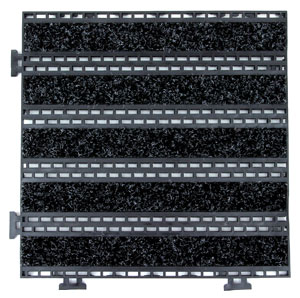 |
In modular matting, PVC can be combined with inserts to aggressively trap dirt, mud, and snow. |
Used in combination with vestibule matting, interior walk off mats clean and dry any residual dirt and moisture. Walk off mats cannot be recessed and are generally a carpeted rubber-backed mat situated just inside a building. Interior walk off mats typically feature a coarse-ribbed surface, a nylon fiber that has acceptable soil wiping properties, or carpeting that can absorb soil particles. Commercial walk-off mats can be at least ten feet in length and have a rubber backing and an edge around the perimeter to achieve a non-skid surface that holds firmly to the floor. The fibers should show resiliency after cleaning and not “crush out” quickly which makes the mat ineffective. Walk off mats are usually not specified by architects, and fall under the purview of the building management.
Depending on climate and foot traffic, a comprehensive matting system with maximum coverage may involve a three-mat system that involves an outside scrapper mat, a bi-level vestibule mat, and an interior walk-off finishing mat. Particularly in areas with heavy snow, a matting system comprising outdoor entrance mats together with vestibule mats may be required.
What Architects Should Consider in Specifying an Entrance Mat
The Right Size Mat
Opinions vary on the right sized mat. Most people entering a building do not stop to wipe their feet, so it is important to have a mat long enough to ensure that soil and snow are removed before shoes hit the building floors. According to the Carpet and Rug Institute, mats that extend for 6 to 15 feet inside the entrance will trap eighty percent of soil and moisture from the first five or six steps. Some manufacturers recommend six to eight feet of matting in a commercial vestibule and coverage of the entire vestibule in a retail situation. Others recommend 18 to 20 feet of entrance flooring to ensure removal of soil and moisture, enough for the average adult to take six to eight three-foot-long strides.
To properly specify the right sized mat, architects should consider the following issues:
- The amount of foot traffic expected.
- Whether the entrance has an outside cover
- The likelihood of traffic from carts or buggies
- Climate characteristics
Slip Resistance
The National Floor Safety Institute (NFSI) certifies mats as Slip Resistant based on a series of tests. The coefficient of friction is the most common way to determine the expected safety of the surface. There are two types of friction and friction coefficients; static and dynamic. The static coefficient of friction measures the amount of energy required to move a stationary object across a surface. The dynamic coefficient of friction measures the energy required to keep an object moving. These require two different levels of energy. Among flooring product manufacturers, it is more common to measure the static coefficient of friction. The American Society for Testing and Materials (ASTM) has established several methods for testing coefficients of friction for floors and floor coatings, with much debate as to the proper method. Most studies show that people can walk comfortably and safely on surfaces with a coefficient of friction greater than 0.4. The Occupational Safety and Health Administration (OSHA) recommends a flooring surface with a coefficient of friction greater than 0.5. The Americans with Disabilities Act recommends higher coefficients of friction for some applications. Accessible routes should have a coefficient of friction of 0.6 and ramps should be .80. Underwriters Laboratories (UL) standard also requires a 0.5 coefficient of friction (UL 410).
One of the key triggers of potential trip hazards revolves around “transitions,” or changes in the walking surface due to mats. The problem of transitions is a main reason why carpet mats are undesirable in many circumstances. Carpet mats tend to wrinkle and pose a hazardous situation that intensifies with the wetter and older the mat. By contrast, modular tiles are molded and remain flat. Most importantly, however, is an effective maintenance program which should be in place after the building is completed and occupied.
Design Details
Generally, modular matting is available in ¼ to ½ inch profiles. In selecting a profile, it’s important to conform to the depth of the recessed area into which the mat will fit. Thicker does not correlate to more effective—the efficacy of the open grid modular mat lies in the top surface which provides the cleaning function. With tiles that interlock using male and female tabs, architects can specify an entrance mat of any shape, width or length.. The modular nature of the tile mats facilitates positioning in front of any size or number of doors.
 |
Modular matting is typically available in ¼ and ½ inch profiles. |
In modular matting, colors for tiles and carpet inserts may be freely intermixed to create patterns and color combinations of any design. Carpet colors can be mixed on any individual tile unit as well. PVC mats are integrally colored units. The plastic colorant is very stable indoors, and while colorant is typically warranted for 5 years, mats often last twice that long with very little variation in color quality.
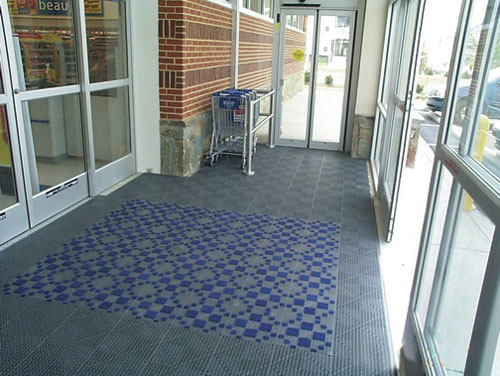 |
Colors for tiles and carpet inserts can be freely intermixed to create striking patterns. |
Installation Considerations
With matting products, successful installation and maintenance are keys to good performance. To ensure a successful application, architects should at least be aware of installation procedures.
Modular design enables designers to create an entrance mat of almost any length, width or shape. Typically, modular mats are assembled on site. Large mats can be made by shop assembling sub-sections up to 5’ x 5’ for final installation in the field. The norm is “loose laid.” Surface applied mats include a tapered edge ramp around the perimeter to make a smooth transition from adjacent surfaces to the walking surface. PVC interlocking mats can also be recessed at entrances and other areas requiring the mat to be flush with the adjacent surface. They connect using integrally molded tab connections on all four sides of each tile. There are male tabs on two adjacent sides of each tile that mate with corresponding female slots on adjacent sides of each tile. Typically the strength of tab connections is suitable for standard or harsh pedestrian applications or standard wheeled cart traffic.
When high strength tile-to-tile connections are needed, as in high abuse areas, where wheeled cart traffic will be present or in assembling large mats, specify stainless steel staples, shot through each tab, parallel to the walking surface. These staples split as they penetrate the tab to lock securely in place and will not come up through the surface.
If desired, each tab can be glued using certain types of PVC cement or matting adhesive. If gluing is to be done on site, architects should specify "cement tab connections at job site." Cemented tab connections are essentially permanent.
For further flexibility, PVC tiles can be easily cut in the field to clear columns, counters, or equipment. A utility knife with a sharp blade or a "finishing" blade on standard sabre, jig, band or table type power saw will make smooth, precise cuts.
It’s also important to note that when PVC tiles are installed in a recessed area, 1/8” should be left around the perimeter for possible expansion or contraction due to weather.
Maintenance Issues
To enable mats to continue to perform well, comprehensive maintenance is critical. Mats need to be cleaned regularly for optimum performance. An unclean mat will actually contribute to additional soil being tracked into a building The underside of mats should be cleaned and dried regularly as well to minimize the potential for mold. In general, a maintenance regime will comprise daily vacuum cleaning and soil removal; a weekly water and detergent cleaning; and periodic extraction cleanings.
PVC tiled entrance matting is usually cleaned using a broom, vacuum, damp mop or regular hose and plain water. For a very thorough cleaning, a special commercial degreaser and a scrub brush should be used. A contained power washer that extracts and vacuums the wash water from the tile and sends it back to the waste tank is recommended. Recommended PSI is 800, and water temperature should be between 120 and 150 degrees.
In terms of maintenance, modular tiles are easily replaceable. For instance, if tiles in the center “power alley” start to show wear and tear, they can be rotated with other tiles on the edge of the matting that have not received as much foot traffic, and prolong the life of the mat. Damaged tiles can be replaced one unit or section at a time by lifting out the damaged unit and snapping a new unit into the mat or ramp. There is no need to replace the whole surface if only a portion is damaged. For stapled or cemented installations, the manufacturer should be contacted for specific replacement and repair procedures.
If conducted properly, mat maintenance will contribute to the building’s aesthetics as well as preventing the spread of dirt into the interior and the potential for accidents.
A Key Factor in Asset Protection
Entrance matting is a vital part of a building’s soil management and asset protection programs. Mats with bi-level construction have the dual advantage of both scraping and storing soil and moisture so it does not reattach to footwear and become tracked into the interior of the building, damaging floor surfaces and creating trip and fall hazards. Today’s modular entrance mat systems enable a new level of design flexibility and superior performance. Architects concerned with sustainability can select from products that incorporate increasing levels of recycled materials.

